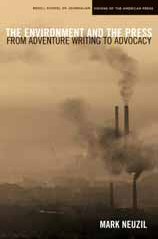SEJournal Online is the digital news magazine of the Society of Environmental Journalists. Learn more about SEJournal Online, including submission, subscription and advertising information.

BookShelf
The Environment and the Press: From Adventure Writing to Advocacy
By Mark Neuzil
Northwestern University Press, $24.95 (paperback)
Reviewed by BILL KOVARIK
Fifteen years ago, when Mark Neuzil and I worked on Mass Media and Environmental Conflict, we seemed to be confronting a deep-seated historical myth about the environment.
According to this myth, the rise of concern about environmental issues was a product of the social turmoil of the 1960s — a Luddite reaction to science, technology, and reason itself.
Media historians contributed a miniature version of this environmental myth by assuming that the press had not taken a serious interest. According to the mini-myth, the once-slumbering media only awoke when there were dramatic events in the late 1960s and early 1970s, such as the Earth Day, the Cuyahoga River fire, and the Buffalo Creek disaster.
Although drama does attract media, the myth itself was appallingly inaccurate. It also missed the far greater opportunity for media historians to help open a then-emerging field of environmental history.
With The Environment and the Press, it now seems possible to lay these myths to rest.
Neuzil had been steadily chipping away at these myths with previous books, such as the previously mentioned Mass Media and Environmental Conflict (which was episodic rather than comprehensive) and in recent years, A Spiritual Field Guide, and Views on the Mississippi.
However, The Environment and the Press is the real mythbuster. It is by far the most comprehensive history of the field to date, exploring connections between journalism and the social context of environmental reform and advocacy.
The book begins with a discussion of the prophetic voice of the press, for example, with Aldo Leopold comparing Teddy Roosevelt to the prophet Ezekiel. While some journalists have been called "false prophets" of doom over the years, many examples of accurate predictions — for example, the warnings around the Katrina disaster — have a resonance in age-old storytelling, Neuzil reminds us, such as the Genesis story of the flood or the story of Jonah and the whale.
Within this broad historical horizon, Neuzil describes agricultural journalism, nature writing, mainstream journalism and new media. The field is populated by prophets, advocates, observers and community builders, and the story is threaded through both narrative and analysis. For some historians this is a tricky terrain to navigate, but Neuzil has a knack for pulling it off with deep insight and remarkable clarity.
As might be expected, Neuzil notes that sometimes the mainstream media led the coverage, and sometimes it followed.
Among the leaders was Sam J. Shelton of the St. Louis Post Dispatch — a reporter on the series of "smoke abatement" articles and editorials that won the Pulitzer Prize in 1940. Not only did Shelton report on air pollution, but he promoted alternatives to bituminous coal and wrote the newspaper's editorial comment toward the end of the campaign: "A great city has washed its face, and its neck and ears too… The plague of smoke and soot has been so well wiped off, if not completely removed, that the shining countenance of the Missouri metropolis is now the envy of other cities still subject to the winter's outpouring of dirt and fumes from thousands of chimneys." This is Pulitzer-style civic crusading, and few people in St. Louis complained.
In other cases, the mainstream media became interested only after labor or specialized publications uncovered disturbing stories with dramatic value. One of these instances involved labor publications that carried stories about the "village of walking skeletons" in the Gauley River — Hawk's Nest disaster of 1931-34, in which African-American workers died of silicosis by the hundreds due to gross negligence. Only after the labor publications ran the story did the mainstream media report the case.
Neuzil documents other cases where non-mainstream media led the way. One of these was the Sierra Club's use of documentary film in its successful campaign to save Dinosaur National Monument from the dam-builders of the Bureau of Reclamation in the early 1950s. Environmentalists carried film projectors around the halls of Congress, showing the Dinosaur film to everyone who would sit still for 28 minutes. The growing interest in the issue attracted the attention of the mainstream media and politicians.
The book also takes us almost up to the present day with broadcasting and new media, describing the history of PBS' Living on Earth, the development of CNN's Assignment Earth, and the approaches taken by Discovery Channel. The book also describes the background of magazines like E Magazine and web sites like Grist. However, some of the most recent developments, such as the demise of CNN's science and environment unit, will need to be included in a second edition.
Neuzil also recounts the development of the Society of Environmental Journalists following a 1989 invitation by Scripps-Howard executive David Stolberg, followed by the organization's first conference in 1991 as interest in environmental coverage grew with environmental Pulitzer Prizes in 1990 and the pending Rio conference on the environment.
How the trends of environmental journalism will develop is an open question, and Neuzil asks whether a new form of moralistic, values-based journalism will overtake the social responsibility model.
Seen in the historical context, the ebb and flow of environmental journalism has continued from its beginnings in ancient texts and Izaak Walton through nature writers and science writers to the beat system and online media.
The historical thread that holds it together is the concern with storytelling, and Neuzil has given us the history of the story of the millennia.
Bill Kovarik is a communications professor and coordinator of the journalism program at Radford University in Virginia.
** From the quarterly newsletter SEJournal, Spring 2010 issue.













 Advertisement
Advertisement 



